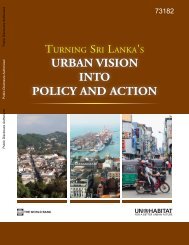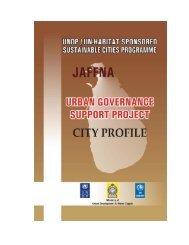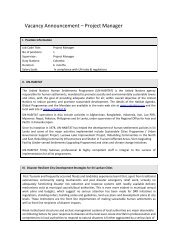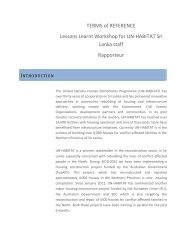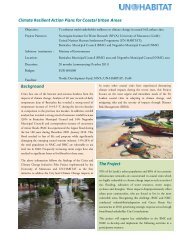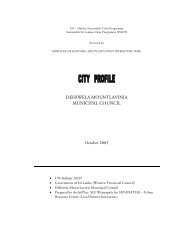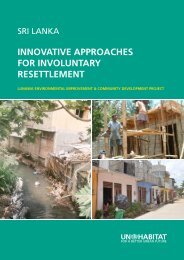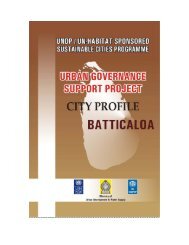Conference Proceedings : âJANASEVANAâ National ... - UN HABITAT
Conference Proceedings : âJANASEVANAâ National ... - UN HABITAT
Conference Proceedings : âJANASEVANAâ National ... - UN HABITAT
Create successful ePaper yourself
Turn your PDF publications into a flip-book with our unique Google optimized e-Paper software.
Urban Housing<br />
In commonwealth economies, public housing dates from 1921 ‐‐ when the first British Housing Minister built a small<br />
number of homes for the poorest of the urban workforce. Since then, the issue of urban housing has expanded<br />
significantly and includes more than mere house planning and architectural design. It also includes solutions for the<br />
local economy such as livelihoods and infrastructure development as well as environmental concerns. The key issue<br />
for developing countries is to generate their own integrated national design. Hence, countries should plan for the<br />
development of local firms and their role as partners and entrepreneurs of the affected communities. The digital<br />
divide and solutions to urban administration also need to be considered.<br />
Private Sector Participation<br />
The key to urban housing and urban development depends on how well the local economy can harness the private<br />
sector. However, this cannot be solved by creating a sheltered, monopolistic private sector. Instead, it should be<br />
competitive and also include communities and social entrepreneurship from low‐income levels. The private sector<br />
perception of the urban challenge is different to that of the Government. For the private and social entrepreneur<br />
sector, the challenge is in harnessing the bottom of the pyramid (BOP population) into development and the property<br />
and financial holdings ladder. This means that a variety of real estate and infrastructure professionals and business<br />
firms must be developed.<br />
OBSERVATIONS ON CURRENT TRENDS<br />
• The “Haussmann” type of planning method is no longer used. People are no longer forced to adapt to plans<br />
developed by the planners.<br />
• In the developed countries, an increase in development by subdivision has been observed.<br />
• There is an apparent divide in directions in the major developed or developing country activities and these may<br />
be termed as a tendency to a central concept as in the “Renaissance” or “Sustainable” model on the one hand<br />
and the “Subdivisions” model on the other. The latter seems to be more practical and is the main model used<br />
today.<br />
Economics<br />
The • world In most has developing not completely countries recovered there seems from to the be Global a furtherance Financial of Crisis the International of 2008. Although style and certain concepts countries have<br />
returned to pre‐crisis levels of house‐building, some problems still remain. In developed economies, a new<br />
In developed economies, a further phenomenon has been observed – namely, the rise of de‐population of some cities<br />
and urban areas while others thrive. While this has been a feature of mature industrialization, the permanence and<br />
effective declines are now becoming more numerous. On the other hand, in developing countries, impoverishment<br />
and implosion of cities has been observed while there has been corresponding throttling of growth and explosion of<br />
the poor population of other cities. This economics must be seen in tandem with the globalization effects on urban<br />
areas. This is the rapid and continued rise of urbanization,<br />
with more than half the world’s population now living in<br />
dense urban areas. Due to the rise of poverty, the rise of<br />
slums or shanties is increasing at an even greater rate.<br />
The Case Study of India<br />
With globalization, the problem of inner city breakdown has<br />
worsened in India. When the World Trade Organisation<br />
(WTO) became operational, India had 34 million workers in<br />
the textile industry, with almost all workers living in city<br />
centres. This meant that the city centres had large<br />
unemployed but skilled pools of labour. India has solved this<br />
problem using two key features. Firstly, the Indian<br />
Constitution requires planning to be at the Local Government<br />
level – which is the highest permissible level of planning. The<br />
The REEL concept<br />
The REEL concept was formulated as an alternative to<br />
‘supply driven social housing’. The concept is based on<br />
land sharing and trading with new housing units<br />
between the government and the slum dwellers. This<br />
process enables the government to use prime lands<br />
which are occupied by the slum dwellers for urban<br />
development while providing decent housing as an<br />
alternative to slums. The key is the mobilization of the<br />
capitalization of the wealth of the city in the form of<br />
the land value of slums.<br />
<strong>Conference</strong> <strong>Proceedings</strong> – <strong>National</strong> Housing Symposium 20




